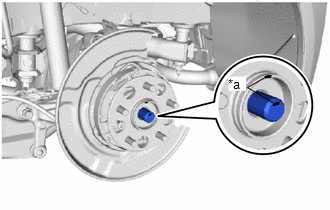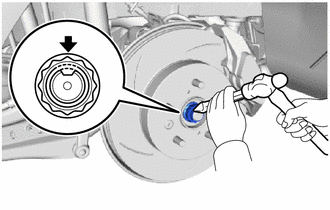Toyota Yaris: Rear Axle Hub / Installation
INSTALLATION
CAUTION / NOTICE / HINT
HINT:
- Use the same procedure for the RH side and LH side.
- The following procedure is for the LH side.
PROCEDURE
1. INSTALL REAR AXLE HUB AND BEARING ASSEMBLY
| (a) Align the matchmarks on the rear drive shaft assembly and rear axle hub and bearing assembly. NOTICE: Be careful not to damage the thread portion of the rear drive shaft assembly. |
|
(b) Install the rear axle hub and bearing assembly to the rear axle carrier sub-assembly with the 4 bolts.
Torque:
90 N·m {918 kgf·cm, 66 ft·lbf}
NOTICE:
Be careful not to damage the drive shaft boot.
2. INSTALL REAR DISC
Click here

3. INSTALL REAR DISC BRAKE CALIPER ASSEMBLY
Click here

4. TEMPORARILY TIGHTEN REAR AXLE SHAFT NUT
(a) Clean the threaded parts on the rear drive shaft assembly and a new rear axle shaft nut using non-residue solvent.
NOTICE:
- Be sure to perform this work even when using a new rear drive shaft assembly.
- Keep the threaded parts free of oil and foreign matter.
(b) Using a 30 mm socket wrench, install the rear axle shaft nut.
Torque:
216 N·m {2203 kgf·cm, 159 ft·lbf}
NOTICE:
Stake the rear axle shaft nut after inspecting for looseness and runout in the following steps.
HINT:
Depress the brake pedal to prevent the drive shaft from rotating.
5. SEPARATE REAR DISC BRAKE CALIPER ASSEMBLY
Click here

6. REMOVE REAR DISC
Click here

7. INSPECT REAR AXLE HUB BEARING LOOSENESS
Click here

8. INSPECT REAR AXLE HUB RUNOUT
Click here

9. INSTALL REAR DISC
Click here

10. ADJUST PARKING BRAKE SHOE CLEARANCE
Click here

11. INSTALL PARKING BRAKE SHOE ADJUSTING HOLE PLUG
Click here

12. INSTALL REAR DISC BRAKE CALIPER ASSEMBLY
Click here

13. STAKE REAR AXLE SHAFT NUT
| (a) Using a chisel and hammer, stake the rear axle shaft nut. |
|
14. CONNECT REAR SPEED SENSOR
(a) Install the rear speed sensor to the rear axle carrier sub-assembly with the bolt.
Torque:
8.5 N·m {87 kgf·cm, 75 in·lbf}
NOTICE:
- Keep the tip of the rear speed sensor and installation hole free of foreign matter.
- Firmly insert the rear speed sensor body into the rear axle carrier before tightening the bolt.
- After installing the rear speed sensor to the rear axle carrier, make sure that there is no clearance between the rear speed sensor stay and rear axle carrier. Also make sure that no foreign matter is stuck between the parts.
15. INSPECT AND ADJUST PARKING BRAKE LEVER TRAVEL
Click here

16. INSTALL REAR WHEEL
Click here

17. CHECK FOR SPEED SENSOR SIGNAL
Click here

 Removal
Removal
REMOVAL CAUTION / NOTICE / HINT HINT:
Use the same procedure for the RH side and LH side.
The following procedure is for the LH side.
PROCEDURE 1...
Other information:
Toyota Yaris XP210 (2020-2026) Reapir and Service Manual: Turbocharger/Supercharger Inlet Pressure Sensor "A" Circuit Low Circuit Short to Ground (P012A11)
DESCRIPTION The internal sensor in the E.F.I. vacuum sensor assembly detects the air inlet duct internal pressure as a voltage. DTC No. Detection Item DTC Detection Condition Trouble Area MIL Note P012A11 Turbocharger/Supercharger Inlet Pressure Sensor "A" Circuit Low Circuit Short to Ground The output voltage from the E...
Toyota Yaris XP210 (2020-2026) Reapir and Service Manual: Diagnostic Trouble Code Chart
D..
Categories
- Manuals Home
- Toyota Yaris Owners Manual
- Toyota Yaris Service Manual
- G16e-gts (engine Mechanical)
- Opening and Closing the Liftgate/Trunk Lid
- How to connect USB port/Auxiliary jack
- New on site
- Most important about car
Break-In Period
No special break-in is necessary, but a few precautions in the first 600 miles (1,000 km) may add to the performance, economy, and life of the vehicle.
Do not race the engine. Do not maintain one constant speed, either slow or fast, for a long period of time. Do not drive constantly at full-throttle or high engine rpm for extended periods of time. Avoid unnecessary hard stops. Avoid full-throttle starts.


